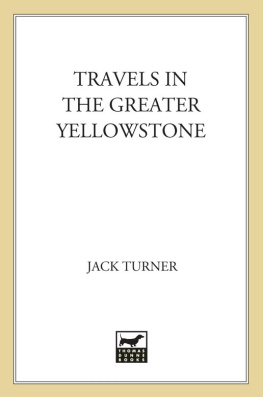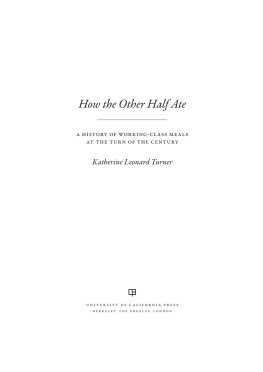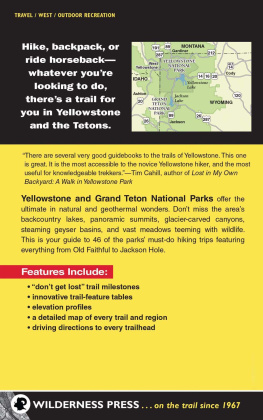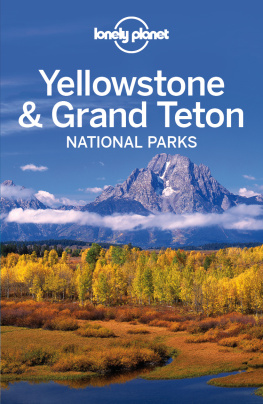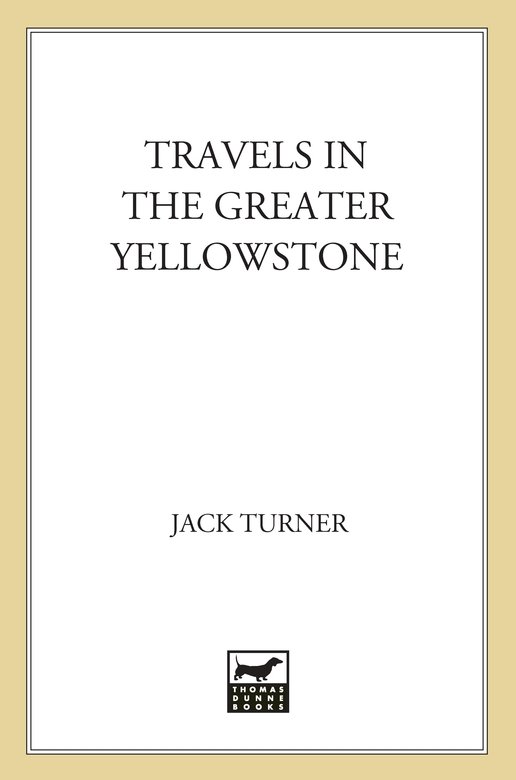I thank my companions on these travels for their fellowship and good spirits, sometimes under trying conditions: Boots Allen, Renee Askins, Dan Burgette, Greg Goodyear, Charlie Craighead, Dick Dorworth, Joe Kelsey, Rod Newcomb, Bob Schuster, and Dana Turner.
Friends and family often provided generous and timely support during the five years it took to write this book. My heartfelt thanks to each of you.
Change in Greater Yellowstone is so rapid that books on the subject are often out-of-date. I have relied instead, for the most part, on the Web sites, newsletters, reports, bulletins, and alerts from conservation groups. The following organizations track events and conduct research and promote conservation in Greater Yellowstone. Each and every one deserves the support of everyone who loves the ecosystem: Alliance for the Wild Rockies, Audubon Society, Biodiversity Conservation Alliance, Biodiversity Legal Foundation, Campaign for the Snake Headwaters, Cougar Fund, Defenders of Wildlife, Earthjustice, Federation of Fly Fishers, Friends of the Teton River, Foundation for North American Wild Sheep, Grand Teton National Park Foundation, Great Bear Foundation, Greater Yellowstone Coalition, Henrys Fork Foundation, Jackson Hole Alliance, Jackson Hole Land Trust, Predator Conservation Alliance, NationalResources Defense Council, Nature Conservancy, Rocky Mountain Elk Foundation, Snake River Fund, Wilderness Society, Wyoming Outdoor Council, Trout Unlimited, Trumpeter Swan Society, Upper Green River Valley Coalition, Whitebark Pine Ecosystem Foundation, Wildlife Conservation Society, and Yellowstone Park Foundation.
The following publications are essential reading for anyone who wants to understand Greater Yellowstone and I have profited from the depth and breadth of their journalism: High Country News, Jackson Hole News and Guide, Wyoming Wildlife , and Yellowstone Science .
The following artists, writers, teachers, and warriors supplied inspiration : Russell Chatham, Nelson Foster, Jim Harrison, Ted Kerasote, Tom McGuane, Peter Matthiessen, John Passacantando, Andrea Peacock, Doug Peacock, Flo Shepard, Paul Shepard, Gary Snyder, Casey Walker, Louisa Wilcox, Terry Tempest Williams, Brooke Williams, Todd Wilkinson, Ted Williams, and George Wuerthner. They are my heroes.
Dan Burgette, former sub-district ranger at Grand Teton National Park; Steve Cain, chief resource biologist at Grand Teton National Park; Mark Gocke, regional public information officer at the Wyoming Game and Fish Department; and Lloyd Dorsey, at the Jackson Office of the Greater Yellowstone Coalition answered many of my questions over the years, and when they could not answer my questions, always directed me to a knowledgeable source. Though from different institutions, they all serve the cause of Greater Yellowstone. Joe Kelsey, Steve Kobylski, and Tom Mangelsen kindly provided photographs.
My companions on these journeys read the chapters they appear in and offered incisive comments. Dick Dorworth and Joe Kelsey read the entire manuscript. Their vast knowledge of the ecosystem, their many journeys through it over the years, and the fact that they are accomplished writers made this a better book than I ever could have written alone. Diane Meitz reviewed the final manuscript andoffered felicitous suggestions. My wife, Dana, read the book more times than I am prepared to admit, always with thoughtfulness and care. My debt to her is infinite.
Nine bows to all.
Opinions expressed here are mine. So are the mistakes.
JACK TURNER
Lupine Meadows
Grand Teton National Park
Jack Turner is the president of Exum Mountain Guides and School of American Mountaineering in Grand Teton National Park. He has led treks in India, Pakistan, Nepal, China, Tibet, Bhutan, and Peru. His first book was a collection of environmental essays, The Abstract Wild; it was followed by a memoir, Teewinot: A Year in the Teton Range . He is a visiting scholar at the University of Utah, and has been honored with a 2007 Whiting Foundation Writers Award. He lives in Grand Teton National Park with his wife, Dana, and their dog, Rio.
Introduction: The Greater Yellowstone Ecosystem
Chittenden, Hiram Martin. The Yellowstone National Park: Historical and Descriptive . Cincinnati: Robert Clarke, 1903.
Gaines, Ernest J. A Gathering of Old Men . New York: Vintage, 1992.
Leopold, Aldo. The River of the Mother of God and Other Essays by Aldo Leopold. Edited by Susan L. Flader and J. Baird Callicott. Madison, WI: University of Wisconsin Press, 1991.
Noss, Reed, George Wuerthner, Ken Vance-Borland, and Carlos Carroll. A Biological Conservation Assessment for the Greater Yellowstone Ecosystem: Report to the Greater Yellowstone Coalition. Corvallis, OR: Conservation Science, 2001. A copy of the report can be obtained by writing them at: 7310 NW Acorn Ridge Corvallis, OR 97330.
Prichard, James A. Preserving Yellowstones Natural Conditions: Science and the Perception of Nature . Lincoln, NE: University of Nebraska Press, 1999.
Schullery, Paul. Searching for Yellowstone: Ecology and Wonder in the Last Wilderness . Boston: Houghton Mifflin, 1997.
U.S. Department of the Interior. National Park Service. Yellowstone Resources and Issues , 2006 edition.
Wuerthner, George. Yellowstone: A Visitors Companion . Harrisburg, PA: Stackpole Books, 1992.
1. The View from Blacktail Butte
Clark, Tim C. W. The Natural World of Jackson Hole: An Ecological Primer. Moose, WY: Grand Teton Natural History Association, 1999.
Craighead, Charles. The Official Guidebook of Grand Teton National Park . Moose, WY: Grand Teton Natural History Association, 2006.
Craighead, Frank C., Jr. For Everything There Is a Season: The Sequence of Natural Events in the Grand TetonYellowstone Area . Helena, MT: Falcon Press, 1994.
Love, J. David, John C. Reed Jr., and Kenneth L. Pierce. Creation of the Teton Landscape: A Geological Chronicle of Jackson Hole and the Teton Range . Moose, WY: Grand Teton Natural History Association, 2003.
Luoma, Jon R. The Hidden Forest . New York: Henry Holt, 1999.
Madsen, Chris. On the Wild Side: Keeping the Wild in Wildlife Should Be a Primary Goal of Modern Conservation Efforts. Wyoming Wildlife 67, no. 1 (January 2004).
Smith, Robert B., and Lee J. Siegal. Windows into the Earth: The Geologic Story of Yellowstone and Grand Teton National Parks. New York: Oxford University Press, 2000.
Stamets, Paul. Mycelium Running: How Mushrooms Can Help Save the World . Berkeley: Ten Speed Press, 2005.
2. Opening Day on the Firehole River
Back, Howard. The Waters of Yellowstone with Rod and Fly . New York: Lyons Press, 2000.
Brooks, Charles E. The Living River: A Fishermans Intimate Profile of the Madison River WatershedIts History, Ecology, Love, and Angling Opportunities . New York: Winchester Press/Nick Lyons Books, 1979.
Juracek, John, and Craig Mathews. Fishing Yellowstone Hatches . West Yellowstone, MT: First published 1992 by Blue Ribbon Flies, West Yellowstone, MT.
Schwiebert, Ernest G., Jr. Matching the Hatch: A Practical Guide to Imitation of Insects Found on Eastern and Western Trout Waters . New York: Macmillan, 1955.
Varley, John D., and Paul Schullery. Yellowstone Fishes: Ecology, History, and Angling in the Park . Mechanicsburg, PA: Stackpole Books, 1998.

